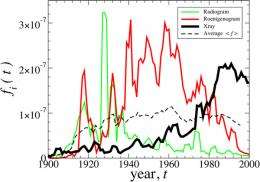Word extinction. The English word “Roentgenogram” derives from the Nobel prize winning scientist and discoverer of the X-ray, Wilhelm Röntgen (1845-1923). The prevalence of this word was quickly challenged by two main competitors, “X-ray” (recorded as “Xray” in the database) and “Radiogram.” The arithmetic mean frequency of these three time series is relatively constant over the 80-year period 1920-2000, 〈 f 〉 ≈ 10^-7, illustrating the limited linguistic “market share” that can be achieved by any competitor. We conjecture that the main reason “Xray” has a higher frequency is due to the “fitness gain” from its efficient short word length and also due to the fact that English has become the base language for scientific publication. Image (c) Scientific Reports doi:10.1038/srep00313
(PhysOrg.com) -- Adding new words to an existing language, or dropping old ones is something people have always done. As new things or ideas are discovered, new words crop up to describe them. But now, in the digital age, that process appears to be slowing despite the increased pace of new things arriving on the scene. In a paper in Scientific Reports, a group from the Institutions Markets Technologies' Lucca Institute for Advanced Studies in Italy, describe how they have found after studying English, Spanish and Hebrew trends, that words are being dropped from languages faster and new ones added at a slower rate, than at any other time over the past three hundred years.
Suspecting that the addition of new words to languages might be inhibited by modern tools such as spellcheckers, the team looked at 107 words that have been recorded by Google as part of its book digitizing process, which is now estimated to represent somewhere near four percent of all of the world’s books. Because they are in digital form, it is possible to perform statistical analysis on them, which is just what the team did. In doing so, they were able to note when new words appeared in a language and then to see if they held on long enough to become permanent, or if they vanished after a certain amount of time. Analyzed works included books from 1800 to 2008.
One of the most striking results the team found was that words being lost from the three languages occurred more often in the past ten to twenty years than in all of the other eras in the period of study. They also found that newer words were being added less frequently during the same period indicating that modern languages are shrinking. They suggest that electronic spellcheckers introduced during this period might be partly responsible for the change, as might the tendency to gravitate towards a smaller vocabulary when writing emails and especially when texting. They also cite the increased use of just one language, English, in science endeavors and projects, regardless of native tongue.
Interestingly, the group also found that when new words are added in the digital age, they tend to become mainstream much faster than occurred in previous years, likely because of the same modern electronic communications tools that are causing languages to constrict. They also found that it generally takes at least forty years for new words to become truly accepted as a part of a language, and if that doesn’t happen, they tend to die.
More information: Statistical Laws Governing Fluctuations in Word Use from Word Birth to Word Death, Scientific Reports 2, Article number: 313 doi:10.1038/srep00313
Abstract
We analyze the dynamic properties of 107 words recorded in English, Spanish and Hebrew over the period 1800–2008 in order to gain insight into the coevolution of language and culture. We report language independent patterns useful as benchmarks for theoretical models of language evolution. A significantly decreasing (increasing) trend in the birth (death) rate of words indicates a recent shift in the selection laws governing word use. For new words, we observe a peak in the growth-rate fluctuations around 40 years after introduction, consistent with the typical entry time into standard dictionaries and the human generational timescale. Pronounced changes in the dynamics of language during periods of war shows that word correlations, occurring across time and between words, are largely influenced by coevolutionary social, technological, and political factors. We quantify cultural memory by analyzing the long-term correlations in the use of individual words using detrended fluctuation analysis.
via Livescience
Journal information: Scientific Reports
© 2011 PhysOrg.com


















